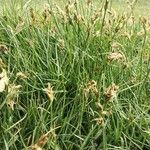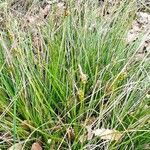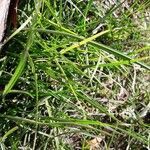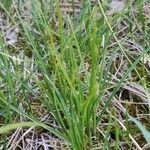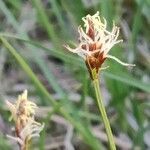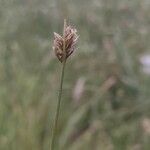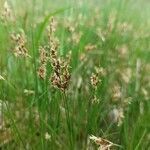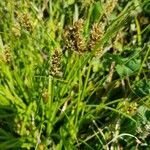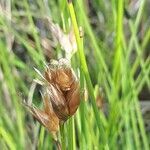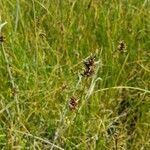Perennial herb, 0.10-0.42 m high, long-rhizomatous. Leaf blades up to 150 x 2.0-2.5 mm, U-to V-shaped, upper surface papillate, lower surface glabrous. Culm scapose, 3-angled, 1 mm in diam. Inflorescence terminal, a dense, foxtail-shaped ‘panicle’, 12-17 x 7-8 mm. Bracts bristle-like. Glomerules 5-7, bisexual, the largest 5 x 2 mm. Female bracts (glumes) longer and wider than perigynium, ovate, 4.5-5.0 x 2.5 mm, keel excurrent into scabrid awn up to 0.3 mm long. Perigynium suberect, 4.2 x 1.8 mm, elliptic in cross section, not inflated, golden-brown, cartilaginous, glabrous, nervose; rostrum 1.5 mm long, apex shallowly bidentate. Flowering time June. Nutlet ovate, broadly clawed, 2.0 x 1.6 mm, narrowly elliptic, yellowish brown, surface glabrous.
Slender tufts; rhizome thick, woody, often far-extending. Stems 20-60-(80) cm, 3-angled, scabrid towards top, slender and wiry. Leaves 1-3.5 mm wide, usually < stems, flat to channelled, grey-green, sheaths very light brown. Inflorescence 1-4 cm long, of up to 8 contiguous dark brown sessile spikes; bract < to > inflorescence, setaceous. Spikes androgynous, male flowers at top. Glumes = or > utricles, broadly ovate, acuminate, dark brown with lighter brown midrib. Utricles ± 4 × 2 mm, broadly ovoid, plano-convex many-nerved, very light brown, abruptly narrowed to a bifid beak 0.5-c. 1 mm long with smooth margins; stipe minute. Stigmas 2. Nut suborbicular, biconvex.
Robust, rhizomatous perennial, up to 0.4 m high. Stem 3-angled, 1 mm in diameter at middle. Leaves shorter than flowering stem, blades V-shaped to flat, 2.0-2.5 mm wide, yellow-green. Flowers: inflorescence glomerate-spicate to glomerate-paniculate; terminal, 12-17 x 7-8 mm, basal bract inconspicuous, occasionally well developed, leaf-like, suberect, bracts of pistillate spikelets longer and wider than perigynia; mature perigynium suberect; stigmas 2; Jun.-Nov. Fruit a square nutlet.
Rhizomatous perennial, erect, 100-420 mm tall. Leaves shorter than flowering stem, blades V-shaped to flat, 2-2.5 mm wide. Stem 3-angled, 1 mm diam. at middle. Inflorescence terminal, a dense foxtail-shaped `panicle', 12-17 x 7-8 mm, basal bract inconspicuous, occasionally well developed, leaf-like, suberect.
Very much like no. 12 [Carex stenophylla Wahlenb.]; spikes mostly 3–8(–12), all or mostly androgynous; perigynium ovate or broadly ovate, evidently nerved dorsally, the body 3–5 times as long as the short beak. Native of Europe, locally intr. in brackish marshes along the coast in Md. and N.C.
